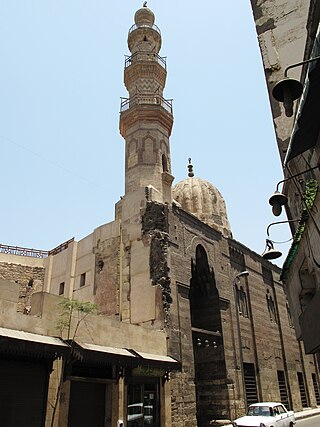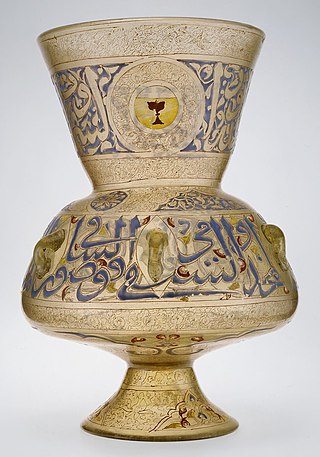
Al-Ashraf Salāh ad-Dīn Khalil ibn Qalawūn was the eighth Bahri Mamluk sultan, succeeding his father Qalawun. He served from 12 November 1290 until his assassination in December 1293. He was well known for conquering the last of the Crusader states in Palestine after the siege of Acre in 1291. While walking with a friend, Khalil was attacked and assassinated by Baydara and his followers, who was then killed under the orders of Kitbugha.

Al-Malik an-Nasir Nasir ad-Din Muhammad ibn Qalawun, commonly known as an-Nasir Muhammad, or by his kunya: Abu al-Ma'ali or as Ibn Qalawun (1285–1341) was the ninth Mamluk sultan of the Bahri dynasty who ruled Egypt between 1293–1294, 1299–1309, and 1310 until his death in 1341. During his first reign he was dominated by Kitbugha and al-Shuja‘i, while during his second reign he was dominated by Baibars and Salar. Not wanting to be dominated or deprived of his full rights as a sultan by his third reign, an-Nasir executed Baibars and accepted the resignation of Salar as vice Sultan.

The Taynal Mosque, also known as the Taylan Mosque, is a historic mosque in Tripoli, Lebanon. It is located on the left bank of the Abu Ali or Kadisha River, in an area of orchards near the Bab al-Raml cemetery. After the Mansouri Great Mosque, it is one of the most important historic and religious monuments in the city.
The Ibn Uthman Mosque is a mosque in Gaza City, in the Gaza Strip, Palestine. It is regarded as second only to the Great Mosque of Gaza in terms of beauty and status as a Friday mosque. Noted for its architectural patterns, the mosque was established in three different stages during the Burji Mamluk period of rule in Gaza.

Shaykhu al-Umari an-Nasiri was a high-ranking Mamluk emir during the reigns of sultans al-Muzaffar Hajji (1346–1347), an-Nasir Hasan and as-Salih Salih (1351–1355).
Sayf ad-Din Tankiz ibn Abdullah al-Husami an-Nasiri better known simply as Tankiz was the Damascus-based Turkic na'ib al-saltana (viceroy) of Syria from 1312 to 1340 during the reign of the Bahri Mamluk sultan an-Nasir Muhammad.
Sanjar ibn Abdullah Alam al-Din Abu Sa'id al-Jawli was a powerful Mamluk emir and the Governor of Gaza and much of Palestine between 1311–20 during the sultanate of an-Nasir Muhammad and then again for a brief time in 1342 during the reign of the latter's son as-Salih Ismail. Prior to his first term as governor, al-Jawli briefly served as the Emir of Shawbak in Transjordan and before his second term as Gaza's governor, he was appointed Governor of Hama for three months.
Al-Sham'ah Mosque or Bab ad-Darum Mosque is a historic mosque located in Hayy al-Najjarin of the al-Zaytun Quarter in Gaza's Old City. Its name Sham'ah translates as "Candle," although the origin of the name is unknown. The mosque does not have a minaret. It was built on 8 March 1315 by the Mamluk Governor of Gaza, Sanjar al-Jawli.

Al-Malik al-Ashraf Sayf al-Din Abu an-Nasr Inal al-'Ala'i az-Zahiri an-Nasiri al-Ajrud was the 13th Burji Mamluk sultan of Egypt, ruling between 1453–1461.
Rukn ad-Din Baybars al-Ala'i al-Hajib was a prominent mamluk of Bahri sultan al-Nasir Muhammad in the early 14th-century. He served as the governor of a number of provinces throughout the Cairo-based Mamluk Sultanate.

Mamluk architecture was the architectural style that developed under the Mamluk Sultanate (1250–1517), which ruled over Egypt, the Levant, and the Hijaz from their capital, Cairo. Despite their often tumultuous internal politics, the Mamluk sultans were prolific patrons of architecture and contributed enormously to the fabric of historic Cairo. The Mamluk period, particularly in the 14th century, oversaw the peak of Cairo's power and prosperity. Their architecture also appears in cities such as Damascus, Jerusalem, Aleppo, Tripoli, and Medina.
An-Nasir Shihab ad-Din Ahmad ibn Muhammad ibn Qalawun, better known as an-Nasir Ahmad, was the Bahri Mamluk sultan of Egypt, ruling from January to June 1342. A son of Sultan an-Nasir Muhammad, he became embroiled in the volatile succession process following his father's death in 1341. An-Nasir Ahmad lived much of his life in the desert fortress of al-Karak in Transjordan and was reluctant to assume the sultanate in Cairo, preferring al-Karak, where he was closely allied with the inhabitants of the city and the Bedouin tribes in its vicinity. His Syrian partisans, emirs Tashtamur and Qutlubugha al-Fakhri, successfully maneuvered to bring Syria under an-Nasir Ahmad's official control, while sympathetic emirs in Egypt were able to oust the Mamluk strongman Emir Qawsun and his puppet sultan, the five-year-old half-brother of an-Nasir Ahmad, al-Ashraf Kujuk. An-Nasir Ahmad eventually assumed the sultanate after frequently delaying his departure to Egypt.
An-Nasir Badr ad-Din Hasan ibn Muhammad ibn Qalawun, better known as an-Nasir Hasan, was the Mamluk sultan of Egypt, and the seventh son of an-Nasir Muhammad to hold office, reigning twice in 1347–1351 and 1354–1361. During his first reign, which he began at age 12, senior Mamluk emirs formerly belonging to an-Nasir Muhammad, dominated his administration, while an-Nasir Hasan played a ceremonial role. He was toppled in 1351 when he attempted to assert executive authority to the chagrin of the senior emirs. He was reinstated three years later during a coup against his brother Sultan as-Salih Salih by emirs Shaykhu and Sirghitmish.
Sayf ad-Din Baybugha Rus al-Qasimi an-Nasiri was a prominent Mamluk emir during the reigns of sultans as-Salih Isma'il, al-Muzaffar Hajji, an-Nasir Hasan and as-Salih Salih.

Sayf ad-Din Qawsun ibn Abdullah an-Nasiri as-Saqi, commonly known as Qawsun was a prominent Mamluk emir during the reigns of sultans an-Nasir Muhammad, al-Mansur Abu Bakr and al-Ashraf Kujuk.

As-Salih Salah ad-Din Salih ibn Muhammad ibn Qalawun (28 September 1337–1360/61, better known as as-Salih Salih, was the Mamluk sultan in 1351–1354. He was the eighth son of Sultan an-Nasir Muhammad to accede to the sultanate. He was largely a figurehead, with real power held by the senior Mamluk emirs, most prominently Emir Taz an-Nasiri.
Sayf ad-Din Sirghitmish ibn Abdullah an-Nasiri, better known as Sirghitmish was a prominent Mamluk emir during the reign of Sultan an-Nasir Hasan. By 1357, Sirgitmish was the most powerful emir in an-Nasir Hasan's court. That year, he had the Madrasa of Sirghitmish built in Cairo. In 1358, the sultan's suspicions of a coup plot by Sirghitmish led to his imprisonment and subsequent death.
Qutlubugha al-Fakhri was a Mamluk emir during the reigns of sultans an-Nasir Muhammad, al-Mansur Abu Bakr, al-Ashraf Kujuk and an-Nasir Ahmad. Qutlubugha had been purchased by an-Nasir Muhammad, who promoted him to the highest Mamluk military rank. He was demoted and exiled to Syria under the protection of Emir Tankiz in 1327 after an-Nasir Muhammad held him responsible for an incident which could have potentially caused a mutiny of Qutlubugha's mamluks against the sultan.
Asad al-Dīn Rumaythah ibn Muḥammad Abī Numayy al-Ḥasanī was Emir of Mecca seven times between 1301 and 1345.








